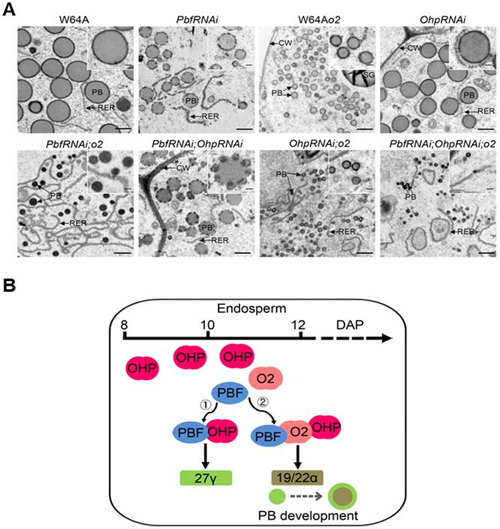Three master regulators of zein gene expression in maize
Maize (Zea mays), commonly known as corn, is one of the most productive crops in the world. Its seeds contain 10% protein, of which >60% are alcohol-soluble proteins called zeins. Although the high-level expression of zein genes is critical for the formation of a hard endosperm, which confers strength to withstand mechanical damage during harvesting, transportation and storage, zein abundance compromises the nutritional value of the grain, because these proteins are devoid of the essential amino acids, lysine and tryptophan.
Zeins are classified into four subfamilies, i.e. α- (19- and 22-kDa), γ- (50-, 27- and 16-kDa), β- (15-kDa) and δ-zeins (10- and 18-kDa), based on their molecular weight and structures. During the 1980s, these genes were identified. Opaque2 (O2) is a bZIP transcription factor, identified as the first transactivator of zein gene expression. O2 transactivates the 22-kDa α-zein genes by recognizing the O2 box (TCCACGT) cis-element. Prolamin-box binding factor (PBF) is a Dof transcription factor, identified as the second transactivator of zein gene expression. PBF transactivates the 27-kD γ-zein gene by recognizing the P-box (TGTAAAG) cis-element. O2 heterodimerizing protein 1 and 2 (OHP1 and OHP2) were identified as bZIP transcription factors by screening an endosperm cDNA library with an O2 probe and could form heterodimers with O2 in vitro. However, their biological functions are unclear.
Since 2013, Dr. Yongrui Wu led the group of “Maize Endosperm Development and Genetic Improvement” at Institute of Plant Physiology and Ecology, Shanghai Institutes for Biological Sciences. Wu lab focuses on identifying important transcription factors in maize endosperm during the filling stage and dissecting their regulatory networks.
Dr. Wu and his colleagues now reveal that OHP1 and OHP2 specifically regulate 27-kDa γ-zein gene expression through binding to an O2-like box (TTTACGT) in its promoter and interact with PBF. Through creating the double and triple mutants of o2, PbfRNAi and OhpRNAi, they find the three transcription factors regulate 90% of zein gene expression in an additive and synergistic way. So the three transcription factors serve as master regulators of zein gene expression, which helps determine the hardness and nutritional composition of maize kernels. Dr. Wu and his colleagues further propose a model for transcriptional regulation of the 22-kDa α- and 27-kDa γ-zein genes, based on the differential expression patterns of the three transcription factors during protein body formation.
This study entitled “Transcriptional Regulation of Zein Gene Expression in Maize through the Additive and Synergistic Action of opaque2, Prolamine-Box Binding Factor, and O2 Heterodimerizing Proteins” has been published online in The Plant Cell on April 21, 2015.
The research was supported by the Natural Science Foundation of China (31371630, 91335109 and 31422040) and Chinese Thousand Talents Program Grant.
Key Words: Maize (Zea mays), endosperm, seed storage proteins and zein expressing regulation

Figure. Three master regulators of zein gene expression in maize.
(A) TEM images showing the phenotypes of protein bodies (PBs) in different mutant combinations.
(B) A hypothetical model depicting the transcriptional regulation of the 27-kDa γ- and α-zein genes mediated by O2, PBF and OHPs.
Image by Zhang et al., Plant Cell. 2015 Apr 21. pii: tpc.15.00035.
